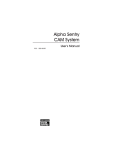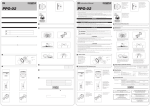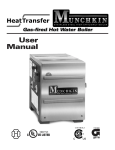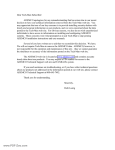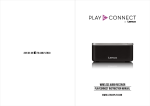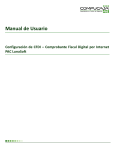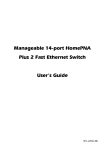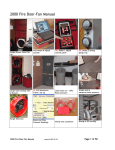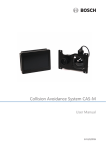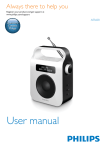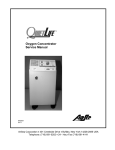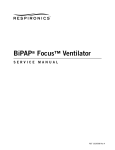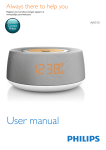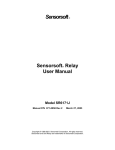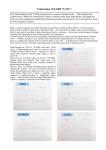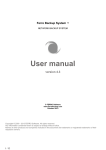Download Alpha Sentry CAM System Data Sheet
Transcript
Alpha Sentry CAM System Features Patented radon reduction ■ screen Patented mass flow meter ■ for accurate air flow measurement High sensitivity lowers ■ false alarm rate Optional interface to ■ laboratory-wide computer for data transfer Precise radon stripping ■ algorithm Cleanable, rugged high ■ resolution detector Patented disposable filter ■ cartridge assembly saves time and labor Distributed architecture ■ reduces sampling location cost LCD screen displays ■ spectral data and historical trends Continuous self diagnostics ■ ensure system health Full compliance with ■ ANSI N42.17B specifications US Patent 5,128,539 US Patent 5,404,762 US Patent 5,337,603 Description The Alpha Sentry System The Alpha Sentry Continuous Air Monitor (CAM) System resolves many of the issues facing Alpha CAM users today. A patented diffusion screen removes 95% of the unattached radon daughters from the air sample (as much as 90% of the radon daughters are unattached in typical laboratory environments). In addition, the spectroscopic algorithm (which uses a stripping method instead of ROIs) is extremely effective at subtracting out the radon daughter interference from the transuranic region of interest. This physical and mathematical radon reduction increases the sensitivity of the Alpha Sentry, which in turn translates into a lower false alarm rate. The distributed architecture approach taken by the Alpha Sentry CAM system enables the user to monitor potential leak situations from a point safely outside the affected area. Multi-dropping up to eight sampling heads off a single operator interface (ASM1000), enables the location of the sampling heads in the room while the ASM1000 resides in the hallway. Sharing the operator interface resource lowers the cost per sampling location. It also makes networking to a lab-wide computer easier – there’s only one connection per eight sampling heads. In the Alpha Sentry network, the detector and multichannel analyzer electronics in each sampling head count the activity on the filter and determine if an acute release has occurred. In addition, the ASM1000 reads the spectrum from each head at regular time intervals, applies a precise spectroscopic algorithm, and determines if a chronic release has occurred. In either case, both the sampling head and the ASM1000 signal an alarm. The Sampling Head Based on research conducted by Los Alamos National Laboratory and Texas A&M University’s Aerosol Laboratory, CANBERRA’s sampling head represents the most advanced technology available in Alpha CAMs today. The sampling head contains a patented diffusion screen that removes up to 95% of the newly formed radon daughters particles from the air. Nuclear Measurement Solutions for Safety, Security and the Environment www.canberra.com C26929 – 10/05 Alpha Sentry CAM System Figure 3 In-Line Adapter Allows Direct Connection of Alpha Sentry Head to Pipe or Duct Figure 2 Sampling Head Diagram This is ideal for laboratory environments with HEPA filtered air which have a low concentration of condensation nuclei and hence a low attachment rate. Such facilities typically have high air exchange rates as well, further increasing the fraction of unattached radon decay products. Representative air sampling is ensured by a radial 360° inlet and air channels optimized for uniform particulate deposition on the filter paper. In-line monitoring is available with an optional specially designed manifold. The use of the manifold guarantees results consistent with the open radial inlet application. The in-line adapter (Figure 3) connects to any duct or pipe via 1 in. NPT thread. The sample is uniformly deposited on a filter encased in a cartridge. The patented filter cartridges are designed to save labor and reduce operating costs. When changing filters, the entire cartridge is easily switched, rather than handling flimsy filter paper while wearing gloves. The filter paper within the cartridge is easily removed for further analysis if needed. The activity on the filter is counted by a Passivated Implanted Planar Silicon (PIPS®) detector. This rugged, cleanable detector is available in two sizes: 450 mm2 and 1700 mm2. The larger detector offers greater sensitivity due to increased efficiency and greater possible air flow. The counts from the detector electronics are stored in a 256 channel MCA, where they are continuously monitored for an acute release. Should such an event be detected, the sampling head annunciates an alarm and sends its alarm status to the ASM1000. The alarm device can be either the CANBERRAsupplied optional audio/visual package (driven internally), or the standard SPDT relay contacts can be used to drive custom alarm devices. Two LEDs are present on the head that indicate the counting status – normal or alarm. In addition to collecting the spectrum, the sampling head monitors the flow rate (with a patented mass flow meter), power supply, and detector voltage. It reports these values back to the ASM1000, where it is determined if an alarm condition exists. The sampling head offer full compliance with ANSI N42.17B, including the rigorous EMI/RFI susceptibility tests. The Alpha Sentry Manager The operator interface for either a single sampling head or a network of up to eight sampling heads is the ASM1000 Alpha Sentry Manager. Its function is two-fold: to provide graphical and numerical feedback from the individual heads, and to determine if a chronic release has occurred. Using spectroscopic techniques, the ASM1000 strips the background component due to the 6.0 MeV, 7.68 MeV and 8.78 MeV radon daughter peaks from the plutonium region. If the counts in the Pu region are found to statistically differ from a zero result, the Pu concentration is calculated, and the DAC-hour value determined. Alpha Sentry CAM System This stripping technique is superior to the common ROI techniques, which use predefined regions and empirical constants that do not change to reflect changing conditions. The analysis can also be set up to detect uranium instead of plutonium via simple steps in the user interface of the unit. The background compensation algorithm is applied to each spectrum as it is read in from the sampling head. If the DAC-hour value exceeds the alarm limit, the ASM1000 will sound an alarm itself, as well as at the sampling head location where the condition occurred. The ASM1000 offers an entirely configurable security system. There are four possible security levels to control user access. Each menu can be assigned a security level during system setup. When logging in, only those menus assigned at the user’s security level will be accessible. Menus can be assigned multiple levels. During normal operation, the ASM1000 displays a graphical status of all the sampling heads attached to it, showing bar graphs of the flow rate and the DAC-hour value. In addition to the DAC-hour alarm, the ASM1000 constantly monitors the flow rate, detector voltage, filter drawer status (open/closed) and other operational parameters of the sampling heads and of the network. If a failure is detected (for example, loss of air flow), a trouble alarm is annuciated at both the ASM1000 and individual sampling head locations. The alarm annunciation is entirely configurable during system setup. The relay contacts, visual and audible alarms available at both the sampling head and the ASM1000, can be configured to annunciate during a particular condition. For example, during a trouble alarm the user may choose to illuminate the visual alarm at the head only, and not annunciate any other alarms. The ASM1000 contains an LCD display that provides at-a-glance information for all of the sampling heads connected to it. A pushbutton keypad completes the operator interface. Setup software (Model S578) is available to let a standard personal computer be used for initial setup, such as entering alphanumeric IDs for each sampling head. Software (Model S579) is also available to download new ASM1000 firmware versions, since the firmware is resident in reprogrammable non-volatile memory. The operation of the system through the ASM1000 is entirely menu-driven. Individual head control, maintenance, configuration and historical trend viewing are all controlled through easy-to-follow menus. Both filter changes and performance checks are automated sequences, with on-screen help to guide the operator step-by-step. The last filter change date for each sampling head is tracked automatically by the ASM1000. User-entered pass/fail criteria tell the operator whether the unit is still in calibration after completing a performance check. Figure 4 Main Screen or Multiple Head Configuration In the event that the detectable limit is higher than the alarm limit (due to extreme background conditions), the ASM1000 replaces the user-entered alarm limit with the detectable limit and will annunciate an alarm as soon as the plutonium or uranium is statistically different from the background. At any time, the user can look at a detailed display of an individual spectrum with the touch of a single button. This screen shows the DAC-hour value, flow rate, concentration, alarm status, CAM ID, and last calibration date, in addition to the spectrum. The ability to view the last alarm spectrum and historical trends is also provided. Historical data is stored when the ASM1000 obtains the spectrum from each sampling head. Counts, concentration and DAC-hour values are available as graphical trends. The depth of the history file depends on the number of sampling heads on the network and the poll time of the sampling heads. As much as 24 days of historical data can be stored with a single sampling head polled every 30 minutes. Alpha Sentry CAM System The ASM1000 can be interfaced to a laboratory computer via the optional RS-485 or RS-232 connection. This provides uploading of pertinent data (such as historical trends) for permanent storage and central monitoring as well as the ability to have the computer supply the setup configuration. A single head can be powered directly from the ASM1000, with no need for external connections. The head can be located up to 45 m (150 ft) away under direct power, or up to 1200 m (4000 ft) away via the RS-485 connection. The latter situation requires local power to each sampling head. Multi-dropped CAM Network Each head in a multiple head configuration requires a Network Tee Box (NTB) which provides in-line RS-485 and sampling head connections. The NTB contains individual coding of each sampling head. This type of connection allows easy installation or removal of sampling heads on the network. A Network Terminator (NT) is also required. The multi-dropped network approach, where up to eight sampling heads are connected to a single operator interface (the ASM1000) offers several advantages over a single head CAM: Situations can be monitored from a safe location Potential leaks can be monitored from an ASM1000 located outside the affected area, instead of at the sampling head location. There is no need to suit up to enter a potentially contaminated area only to find it was a false alarm. Low cost per sampling location The cost per sampling location is greatly reduced with up to eight sampling heads sharing the processing power and operator interface of the ASM1000. This reduced cost means additional placements are possible for added protection. Ease of Networking With multiple sampling heads already networked to the ASM1000, there are fewer connections to make when networking all the CAMs to a laboratory-wide computer. You need only connect the single ASM1000, and all the pertinent information from its sampling heads can be uploaded for further analysis, trending and longterm storage. External Communications A standard RS-232 port is provided on the ASM1000 for output to a printer or setup by a local personal computer such as a laptop. This connection provides keyboard support to enter parameters, alarm configuration, passwords, and alphanumeric CAM identifications into the Alpha Sentry system. Operating firmware can easily be updated by downloading from a personal computer into the flash resident in the ASM1000. Host Communications Host Communications Packages are available options for the ASM1000. These options include the necessary hardware, protocol and documentation to communicate to the ASM1000 via a host computer (Figure 5). Multiple Alarming Points Although the sampling heads are connected to a single ASM1000, the workers are not left unprotected if the ASM1000 fails. The intelligent sampling heads, each containing a microprocessor-based MCA, have the ability to detect an acute release on their own, and to drive their own alarms. The ASM1000 annunciates whenever any sampling head on the network is in an alarm state. Diagnostics The ASM1000 contains diagnostics that continuously check the health of the network and itself. Should a problem be detected, an alarm will sound to notify users of any network difficulties. Network Configuration There are two different communication scenarios in the Alpha Sentry system: a single head connected to an ASM1000, and multiple heads multi-dropped off an ASM1000. Figure 5 Example Alpha Sentry Network Alpha Sentry CAM System Specifications SENSITIVITY Under the following conditions that approximate a laboratory environment (37 Bq/m3 (1 pCi/L) radon background, mostly unattached, constant 1 DAC Pu concentration), the sensitivity is approximately 2 DAC-hours with 1700 mm2 PIPS, 2.5 DAC-hours with 450 mm2 PIPS. Under the following conditions that approximate a non-laboratory environment (37 Bq/m3 (1 pCi/L) radon background, mostly attached, constant 1 DAC Pu concentration), the sensitivity is approximately 3.5 DAChours with 1700 mm2 PIPS; 4 DAC-hours with 450 mm2 PIPS. PARTICLE SIZE DEPOSITION EQUIVALENT DIAMETER VS. PERCENT PENETRATION – shown in Figure 6. Figure 6 Equivalent Diameter vs. Percent Penetration UNIFORM FILTER DEPOSITION – 9% Coefficient of Variation for 10 µm AED particles. EFFICIENCY Approximately 33% with a 1700 mm2 PIPS detector; approximately 26% with a 450 mm2 PIPS detector at a fixed detector to filter spacing of 5 mm. BACKGROUND REDUCTION Patented screen removes >95% of newly formed radon daughter products. DETECTOR TYPE – Passivated Implanted Planar Silicon (PIPS). SIZE – Both 1700 mm2 and 450 mm2 are available. SYSTEM RESOLUTION – 1700 mm2 PIPS – typically 450 keV; 450 mm2 PIPS – typically 325 keV. FILTER CARTRIDGE AND FILTER PRESSURE DROP – 12.44 kPa (50 in. H2O) across sampling head with AS047 filter paper, at 0.94 x 10-3 m3/s (2 cfm) using 1700 cartridge or 0.47 x 10-3 m3/s (1 cfm) using 450 cartridge. Filter (Model AS047). TYPE – Millipore® SS. PORE SIZE – 3 µm. ACTIVE DIAMETER – with 1700 PIPS: 42 mm; with 450 PIPS: 24 mm. 450 mm2 OD – 4.765 cm (1.876 in.) ID – 2.390 cm (0.941 in.) Height – 1.91 cm (0.75 in.) 1700 mm2 OD – 4.765 cm (1.876 in.) ID – 4.191 cm (1.650 in.) Height – 1.91 cm (0.75 in.) COMMUNICATIONS NUMBER OF SAMPLING HEADS – Up to eight on a single ASM1000. SINGLE HEAD CABLE LENGTH – 3 m (10 ft) cable standard; maximum distance for single sampling head powered directly from ASM1000 is 45 m (150 ft) using 22 gauge wire for the power cable; maximum distance for single sampling head powered locally is 1200 m (4000 ft). The latter requires a Model CA2001 Network Terminator. MULTI-DROPPED HEAD CABLE LENGTH – Total network distance (RS-485) is 1200 m (4000 ft), maximum. COMMUNICATIONS WITH EXTERNAL COMPUTERS Model ASM01 or ASM02 Communications Package (hardware, protocol and documentation). COMMUNICATIONS PORTS SAMPLING HEAD – RS-485 for communication to ASM1000. ASM1000 – RS-232 for PC setup or printer and RS-485 for communication to sampling head standard; second port optional via Host Computer Interface, Model ASM01 RS-485 Multi-Drop or Model ASM02 RS-232. PHYSICAL WEIGHT – Sampling Head: 3.6 kg (8.0 lb); ASM1000: 4.2 kg (9.3 lb). SAMPLING HEAD – Diameter of head: 17.8 cm (7 in.); diameter including vacuum connection and door knob: 22.9 cm (9 in.); height: 30.5 cm (12 in.). ASM1000 – 31.8 cm (12.5 in.) high; 21.6 cm (8.5 in.) wide; 8.9 cm (3.5 in.) deep, with no mounting hardware. 10.36 cm (4.08 in.) deep with feet or 9.60 cm (3.78 in.) deep with mounting bracket. VACUUM CONNECTION – Male; for 9.5 mm (3/8 in.) ID hose. POWER SAMPLING HEAD – 24 V ac, 50/60 Hz, <15 W. ASM1000 – 100–130 V ac, 60 Hz, 40 W. Fuse – 250 V ac 1/2 A Slow Blow. Alpha Sentry CAM System ENVIRONMENTAL OPERATING TEMPERATURE: Sampling Head – 0 to 50 °C; ASM-1000 – 0 to 50 °C. OPERATING HUMIDITY: Sampling Head – 0-95% relative, non-condensing; ASM-1000 – 0-95% relative, non-condensing. ALARMS Status – ■ Filter Door Open Communication Network Down ■ ■ ■ ■ ■ ■ Low Flow Rate High Flow Rate Detector Voltage Power Exposure – Acute –Chronic ■ Concentration ASM1000 – Standard. AUDIBLE – Selectable 90 or 70 dB (2900 Hz) at 60 cm (2 ft). VISUAL – Amber (trouble) and Red (exposure), 32.3 x 103 lux (3000 end footcandles), average. Relay contacts are standard (SPDT) – 0.3 A at 30 V ac Trouble and Exposure. Sampling Head – Optional. Model AS020 CAM Sampling Head Alarm, one per head: AUDIBLE – Selectable 90 or 84 dB (2900 Hz) at 60 cm (2 ft). VISUAL – >3 watt-second xenon flash tube. Relay contacts are standard (SPDT) – 0.3 A at 30 V ac, Trouble and Exposure. FLOW MEASUREMENT RANGE – 0.24 x 10-3 to 1.42 x 10-3 m3/s (0.5 to 3.0 cfm). RECOMMENDED FLOW SETTING – 0.47 x 10-3 m3/s (1 cfm) for 450 mm2 detector. 0.94 x 10-3 m3/s (2 cfm) for 1700 mm2 detector. Meter TYPE – Hot wire anemometer. Accuracy – ±5%. ANSI 42.17B COMPLIANCE ASM1000, AS450R and AS1700R are fully compliant. UL 61010-1:2004 and CAN/CSA C22.2 No. 61010-1-04 COMPLIANCE ASM1000, AS450R and AS1700R are fully compliant. Table 1 RFI/EMI Susceptibility of Sampling Heads Test Condition AS1700R (Standard) Electric Fields ANSI N42.17B, Step 7.1.2.2: 30 to 35 MHz sweep Vertical >100 V/m Horizontal >100 V/m RF Field ANSI N42.17B, Step 7.1.2.3: 140 MHz Vertical >100 V/m Horizontal >100 V/mv Microwave Field ANSI N42.17B, Step 7.2: 915 MHz Vertical >200 V/m Horizontal >200 V/m Microwave Field ANSI N42.17B, Step 7.2: 2450 MHz Vertical >200 V/m Horizontal >200 V/m Electrostatic Fields ANSI N42.17B, Step 7.3: 5000 V No Effect Alpha Sentry CAM System ASM1000 DISPLAY SIZE – 16.25 cm (6.4 in.) (diagonal). TYPE – TFT – LCD with backlight. RESOLUTION – 640 x 480 VGA. CONTROL PANEL – 24 pushbuttons. INFORMATION DISPLAYED – ■ DAC-hour Value. Flow Rate. ■ ■ ■ ■ ■ ■ ■ ■ Concentration (in user-specified units). Alarm Set Point. Alarm Status. Sampling Head ID and Serial Number. Last Calibration Date for the Sampling Head. MCA Spectrum. Time and Date (accurate to 1 minute per month). ■ Total volume through filter. HISTORICAL DATA STORAGE (for 30 minute poll time) One Sampling Head: 24 days Two Sampling Heads: 12 days Four Sampling Heads: 6 days Eight Sampling Heads: 3 days ASM1000 MENU FUNCTIONS FILTER CHANGE – Provides automated Filter Change sequence and Time/Date stamp. PERFORMANCE CHECK – Provides automated Performance Check sequence and Pass/Fail indication. DATA REVIEW – Historical Trends, Alarm Log and Spectral Data. SYSTEM SETUP – Parameters, Check Source, Individual Head Control, Network Configuration and Calibration. LOG IN/LOG OUT – Allows access to various options according to password level. SAMPLING HEADS AS450R – Radial Inlet with 450 mm2 PIPS. AS1700R – Radial Inlet with 1700 mm2 PIPS. ALPHA SENTRY MANAGER ASM1000 – Alpha Sentry Manager. PIPS is a registered trademark of CANBERRA Industries, Inc. Millipore is a registered trademark of Millipore Corporation. © 2005 CANBERRA Industries, Inc. All rights reserved. OPTIONS Model AS020 Alarm Option for Sampling Head. Model AS010 In-Line Manifold Option for Sampling Head. Model AS031 Filter Cartridges for 450 mm2 Sampling Heads, Package of 25. Model AS032 Filter Cartridges for 1700 mm2 Sampling Heads, Package of 25. Model C2000-X Communications Cable (ASM1000 to Multiple Sampling Heads). Model C2001-X Communications/Power Cable (ASM1000 to single Sampling Head; consists of C2000-X and C2003-X). Model C2002-X Network Access Cable (NTB to head). Model C2003-X Power Cable (ASM1000 to Single Sampling Head). Model C2004 ASM1000/PC Setup Cable; 1.8 m (6 ft) 25-pin to 9-pin. Model CA2000 Network Tee Box (NTB), includes 3 m (10 ft) C2002 and CA2001. Model CA2001 Network Terminator (NT). Model AS047 Filter Paper, 47 mm; package of 100. Model AS050 Wall Mounting Bracket for Sampling Head. Model AS060 Replacement Screen for Sampling Head package of 2. Model AS070 Power Supply for Sampling Head (115 V ac line). Model AS080 241Am Calibration Check Source for AS450R Sampling Heads. Model AS085 241Am Calibration Check Source for AS1700R Sampling Heads. Model ASM01 RS-485 Host Computer Interface. Model ASM02 RS-232 Host Computer Interface. Model S578 Alpha Sentry PC Setup Software and cable C2004. Model S579 Alpha Sentry Configuration and Firmware Update Software and cable C2004. ACCESSORIES Five filter cartridges supplied with each sampling head. One C2001-10 Cable Set and wall mounting kit supplied with each ASM1000. Model AS-MAN Alpha Sentry CAM System User’s Manual; supplied when requested.







